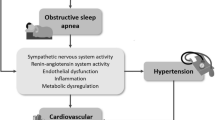Abstract
Purpose
To find the prevalence of obstructive sleep apnoea (OSA) in patient of metabolic syndrome (MS).
Methods
This is a prospective study conducted in the Department of Pulmonary Medicine at IGMC, Shimla. Total 54 patients (32 males and 22 females) with MS who fulfilled inclusion criteria were enrolled for the study over a period of 1 year. The patients who had symptoms of OSA were subjected to overnight polysomnography.
Results
In this study, total prevalence of OSA was 90.74%. Male and female prevalence were 93.75% and 86.36%, respectively. The prevalence of hypertension was 59.25% and 24.49% of the patients were diabetic. An increased neck circumference (corrected for height) has been suggested as a better sign of obstructive sleep apnoea than other clinical indices. We compared male patient of non-OSA with severe OSA and found significant difference in high-density lipoprotein and triglyceride level.
Conclusion
All patients of metabolic syndrome should be screened for OSA because of sheer high prevalence of this disease. Whether the treatment of OSA can have positive impact on MS patients needs to be further studied in Indian settings.

Similar content being viewed by others
References
Younes M. Role of respiratory control mechanisms in the pathogenesis of obstructive sleep disorders. J Appl Physiol (1985). 2008;105(5):1389–405.
Levy P, et al. Intermittent hypoxia and sleep-disordered breathing: current concepts and perspectives. Eur Respir J. 2008;32(4):1082–95.
Ryan S, Taylor CT, McNicholas WT. Selective activation of inflammatory pathways by intermittent hypoxia in obstructive sleep apnea syndrome. Circulation. 2005;112(17):2660–7.
Lavie L. Oxidative stress inflammation and endothelial dysfunction in obstructive sleep apnea. Front Biosci (Elite Ed). 2012;4:1391–403.
Kumar S, et al. ESAT-6 induced COX-2 expression involves coordinated interplay between PI3K and MAPK signaling. Mol Immunol. 2012;49(4):655–63.
Sharma SK, et al. Prevalence and risk factors of syndrome Z in urban Indians. Sleep Med. 2010;11(6):562–8.
Misra A, et al. Consensus statement for diagnosis of obesity, abdominal obesity and the metabolic syndrome for Asian Indians and recommendations for physical activity, medical and surgical management. J Assoc Phys India. 2009;57:163–70.
Wilcox I, et al. “Syndrome Z”: the interaction of sleep apnoea, vascular risk factors and heart disease. Thorax. 1998;53(Suppl 3):S25–8.
Vgontzas AN, Bixler EO, Chrousos GP. Sleep apnea is a manifestation of the metabolic syndrome. Sleep Med Rev. 2005;9(3):211–24.
Agrawal S, et al. Prevalence of metabolic syndrome in a north Indian hospital-based population with obstructive sleep apnoea. Indian J Med Res. 2011;134(5):639–44.
Coughlin SR, et al. Obstructive sleep apnoea is independently associated with an increased prevalence of metabolic syndrome. Eur Heart J. 2004;25(9):735–41.
Peled N, et al. The association of OSA with insulin resistance, inflammation and metabolic syndrome. Respir Med. 2007;101(8):1696–701.
Bonsignore MR, et al. Metabolic syndrome, insulin resistance and sleepiness in real-life obstructive sleep apnoea. Eur Respir J. 2012;39(5):1136–43.
Zito A, et al. Obstructive sleep apnoea and metabolic syndrome in Mediterranean countries. Eur Respir J. 2011;37(3):717–9.
Lam JC, et al. Obstructive sleep apnea and the metabolic syndrome in community-based Chinese adults in Hong Kong. Respir Med. 2006;100(6):980–7.
Drager LF, et al. The impact of obstructive sleep apnea on metabolic and inflammatory markers in consecutive patients with metabolic syndrome. PLoS One. 2010;5(8):e12065.
Venkateswaran S, Shankar P. The prevalence of syndrome Z (the interaction of obstructive sleep apnoea with the metabolic syndrome) in a teaching hospital in Singapore. Postgrad Med J. 2007;83(979):329–31.
Millman RP, et al. Daytime hypertension in obstructive sleep apnea. Prevalence and contributing risk factors. Chest. 1991;99(4):861–6.
Singh A, et al. Polysomnographic study in diabetes mellitus in Central Indian subjects. J Mahatma Gandhi Inst Med Sci. 2012;17:17–21.
Mahmood K, et al. Prevalence of type 2 diabetes in patients with obstructive sleep apnea in a multi-ethnic sample. J Clin Sleep Med. 2009;5(3):215–21.
Meslier N, et al. Impaired glucose-insulin metabolism in males with obstructive sleep apnoea syndrome. Eur Respir J. 2003;22(1):156–60.
Sasanabe R, et al. Metabolic syndrome in Japanese patients with obstructive sleep apnea syndrome. Hypertens Res. 2006;29(5):315–22.
Davies RJ, Stradling JR. The relationship between neck circumference, radiographic pharyngeal anatomy, and the obstructive sleep apnoea syndrome. Eur Respir J. 1990;3(5):509–14.
Katz I, et al. Do patients with obstructive sleep apnea have thick necks? Am Rev Respir Dis. 1990;141(5 Pt 1):1228–31.
Funding
None.
Author information
Authors and Affiliations
Corresponding author
Ethics declarations
Conflicts of interest
All authors declare that they have no conflict of interest.
Additional information
Publisher's Note
Springer Nature remains neutral with regard to jurisdictional claims in published maps and institutional affiliations.
Rights and permissions
About this article
Cite this article
Nagpal, P., Sharma, S., Negi, R.S. et al. Prevalence of Obstructive Sleep Apnoea in Patients with Metabolic Syndrome: A Prospective Observational Study from a Tertiary Care Centre in North India. Sleep Vigilance 3, 151–155 (2019). https://doi.org/10.1007/s41782-019-00077-1
Received:
Revised:
Accepted:
Published:
Issue Date:
DOI: https://doi.org/10.1007/s41782-019-00077-1




